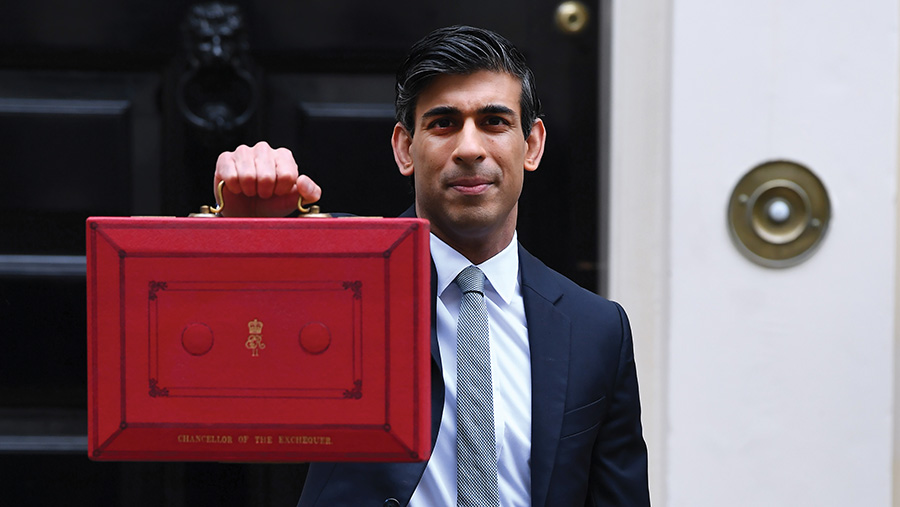Budget give and take is mixed bag for farming
 Chancellor Rishi Sunak
© James Veysey/Shutterstock
Chancellor Rishi Sunak
© James Veysey/Shutterstock Higher capital allowances for some, more Covid-19 support, higher corporation tax rates and the ability to carry back more losses mean the Budget will both help and hit farming operations.
For companies only, chancellor Rishi Sunak’s so-called “super deduction” tax relief offers the ability to offset 130% of investment in new plant and equipment in the year the spending occurs, for the two years from 1 April.
“The enhanced capital allowances will benefit farmers investing in plant, particularly if losses can be carried back three years,” said Andy Ritchie, regional managing partner with accountant Azets.
See also: How to avoid key dates cash crunch with good planning
“Farmers should delay investment until 1 April 2021, when the super deduction commences.”
While personal tax rates were frozen in the Budget and allowances slightly raised for next year, corporation taxes are to rise from April 2023 for companies making more than £50,000 profit.
For profits of between £50,001 and £250,000, rates will be tapered, so that only those making more than £250,000 will pay the new rate of 25%. However, it is estimated that only 10-15% of farms operate their main business as a company.
“The new proposed super deduction is again discriminatory against any businesses operating as partnerships or sole traders,” said Andrew Robinson, a partner at accountant Armstrong Watson.
“It is just the same as the research and development tax credit situation, which is only available to companies. There are many partnerships and family businesses which are investing in these projects and structures that should also get the tax benefits.”
More losses to be carried back
The current tax rules allow trading losses to be carried back for one year. For accounting periods ending between 1 April 2020 and 31 March 2022, this is being extended to three years.
New recovery loans
Business recovery loans of £25,000 to £10m will be available through banks, backed by an 80% government guarantee.
More self-employment grants
Further self-employment grants will be made available for February to April at 80% of profits, followed by May at three months of average profits, with claims opening in late July.
This support will be tapered to provide 80% for those whose turnover has fallen by 30% or more, but only 30% for those whose turnover has fallen by less than 30%.
“There are no immediate changes to inheritance tax, but those farmers and landowners with a clear succession path should still look to pass on property now under the favourable existing legislation,” said Mr Ritchie.
The much anticipated increases in capital gains tax did not materialise, and it is likely that a further announcement or consultation document will be released later in the month, said Mr Robinson.
Help for diversified businesses
With many diversified farms reliant on the Covid-19 measures to support jobs and businesses, the widely leaked extension of the furlough scheme to the end of September has been welcomed.
The business rates holiday for hospitality and tourism businesses will be extended to the end of June, followed by a rates discount.
The 5% reduced rate of VAT on hospitality, accommodation and admission to certain attractions is being extended for six months to 30 September, followed by an interim rate of 12.5% for six months and a return to the standard rate in April next year.
Further grants will be available to non-essential retail businesses, worth between £6,000 and £18,000 for each premises.
Other budget measures and forecasts
- Fuel duty frozen
- No changes to income tax, national insurance or VAT rates
- Personal income tax allowance frozen at £12,570 from 2022 to 2026
- Higher rate income tax threshold frozen at £50,270 from 2022 to 2026
- Personal tax rates frozen
- Inheritance tax and capital gains tax exemptions frozen for next five years
- Doubling apprenticeship help for employers to £3,000
- Communities will be able to claim £250,000 to rescue local pubs and shops from closure
- UK economy forecast to return to pre-Covid levels by mid-2022
- Unemployment expected to peak at 6.5% next year, lower than 11.9% previously predicted
